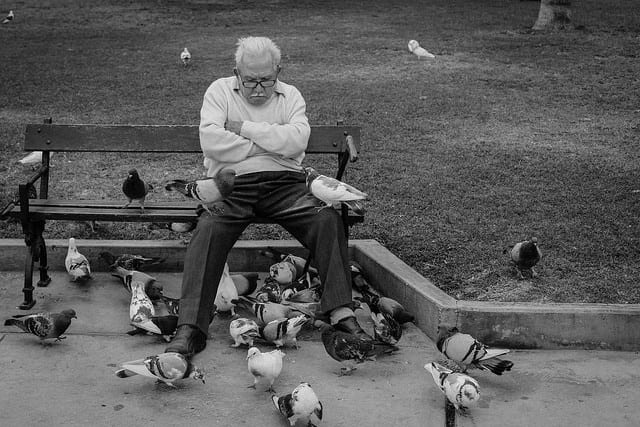
by Pigeon Patrol | Jan 13, 2020 | Animal Deterrent Products, Bird Deterrent Products, Bird Netting, Bird Spike, Bird Spikes, Pigeon Control, Pigeon Droppings, Pigeon Patrol's Services, Pigeon Spikes

Bird droppings on building window
Feral pigeons (Columbia livia) are not harmless birds. Many potential infections of humans silently exist in pigeons which are not apparent. They have the potential for transmission of over 30 diseases to humans plus another ten to domestic animals. Environmental pollution from pigeon droppings is quite evident. Air pollution involves more than noxious gases from automobile exhausts and belching smokestacks. One serious air pollutant is air-borne fungi, which are agents for infectious diseases. There is much information written about the problem, but it remains primarily in the professional journals and technical references, neatly stacked away on library shelves. The objective of this paper is to provide a brief account of the major diseases and to assess their importance. Feral pigeons have been identified with mycotic, bacterial, protozoal, chlamydial, rickettsial, and parasitic diseases as well as dermatosis (Weber 1979). MYCOTIC diseases are not transmitted from humans to humans. Perhaps this is why they do not make the headlines. The fungi causing the diseases are acquired by inhaling the fruiting bodies or spores along with particles of dust. The fungi live saprophytically in feces and soil. Aspergillosis is caused by Aspergillus fumagatus. The fungus produces toxins which poison the victim’s blood. Pigeons assist the spread of the spores in airborne dust. Blastomycosis is caused by Blastomyces dermatitidus. It primarily affects the lungs; the main route of infection is by inhalation of spores. The organism has been isolated from pigeon manure. Candidiasis is caused by Candida spp., chiefly C. albicans. Nearly one-fourth of all mycotic deaths are caused by this yeast. It often affects the mouth, respiratory system, intestines, and urogenital tract, especially the vagina. Incidence of candidiasis (yeast infection) in women is an increasing problem. The discomfort of the itching, pain, and discharge caused by the growth of this fungus is.
ignificant enough to warrant the elimination of pigeons which are one of the three wild birds most frequently infected with Candida. Cryptococcosis is caused by a systemic pathogenic yeast called Cryptococcosus neoformans. No organ or tissue of the body is exempt. It very frequently involves the brain covering as cryptococcal meningitis. One Indianapolis victim spent 91 days in the hospital with cryptococcosis. The yeast is carried in the intestinal tract of pigeons and deposited in their feces (Newberry 1967). One Kansas City survey showed that 93% of the pigeon coops were infected. Histoplasmosis is caused by Histoplasma capsulatum. It is interesting to note that the disease was suggested at one time as a biological warfare agent because of its airborne route (Furcolow, personal communication, 1960). It is probably the second most significant fungus disease. The “summer flu” that midwesterners used to get is now thought to have been histoplasmosis (Personal communication, American Lung Association, 1974). It is basically a pulmonary disease but may extend to the liver, lymph nodes, and spleen. The organism may disseminate to the blood and bone marrow and be fatal. It may lodge in the eye to cause ocular histoplasmosis. Twenty-two cases were reported to the Indiana Board of Health in 1976. Pigeon feces fertilize the soil in such a way as to give the fungus competitive advantage over other soil microorganisms. The largest outbreak ever recorded occurred in Indianapolis during the winter of 1978-79 with over 450 confirmed cases. There were 18 deaths. BACTERIAL DISEASES identified with pigeons are listed. Erysipeloid generally starts in a break in the skin and is accompanied with a sensation of burning, throbbing pain, and intense itching. It is caused by Erysipelothrus insidiosis. Pigeons are involved in its transmission. Listeriosis is caused by Listeria monocytogenes. It causes changes in the cells of the nervous system. It may cause conjunctivitis, endocarditis, and skin infections. It can also cause meningitis in newborns, abortions, premature delivery, stillbirths, and death. The organism has been isolated from pigeons. Parteurellosis is caused by a highly contagious bacteria, Pasteurella multicida. The 157 disease may be divided in four groups of syndromes: 1) infection of the upper respiratory tract as nasal discharge or conjuntivitis, 2) infection of the lower respiratory tract as bronchitis or pneumonia, 3) infecton of internal organs as appendicitis or inflammation of the urinary tract, 4) abscessed wound infections. Pigeons can spread the bacteria through their droppings or nasal discharge. The organism can live as long as a month in pigeon manure or three months in a dead pigeon. Salmonellosis is more than food poisoning. Gastroenteritis is the most common manifestation. Enteric fever or septicemia may follow several weeks later as a relapse. Septicemias often terminate fatally. Persistent infections are less common but very important. There may be an abscess or local infection as arthritis, bronchopneumonia, endocarditis, meningitis, osteomyelitis, or pyeleonephritis. Pigeons are important in the spread of salmonellae, since the bacteria are left wherever the pigeons defecate (MÜller 1965). They trample back and forth through their copious excretion on window ledges and air intake vents. Dusts to contaminate food or homes enter through air conditioners and ventilators. The most common salmonella Isolated from pigeons is Salmonella typhimurum var. Copenhagen, which is found in about 2% of pigeon feces (MÜller 1965). Yersiniosis is a plague-like disease by Yersinia pseudotuberculosos and Y. enterocolitica. The disease is clinically indistinguishable from appendicitis. Both diseases cause fever, nausea, headache, hard and painful stomachs. Because of the similarity, there were 32 school children hospitalized in Oneida County, New York in September 1976. Fourteen were reported to have had unnecessary appendectomies. Y.enterocolitica serotype 8 was isolated from the ill children. It was first isolated from pigeons in 1916. Transmission may be through the feces, eggs, or ticks of pigeons (Hubert 1972). PROTOZOAN diseases include American trypansomiasis, toxoplasmosis, and trichomoniasis. American trypanosomiasis is caused by Trypanosoma cruzi. There is no vaccine, effective treatment, or cure for the disease. It is transmitted through the feces of infected triatimid bugs, as the pigeon kissing bug (Triatoma rubrofasciata). The bugs tend to feed at night while the victim is asleep the bug defecates during or soon after engorgement, and most human infections occur when the bug feces are rubbed into eyes or mucous membranes following a bite. Toxoplasmosis may be one of the most widespread zoonotic diseases in the United States. It is caused by Toxoplasma gondii. It has been shown to cause abortions in women (W.J. Schneider, personal communication, 1977). The organism seems to have an affinity for brain tissue; it may cause mental retardation and death. Pigeons frequently transmit toxoplasmosis through fecal contamination, respiratory droplets, eye secretions, contact with infected tissue, or through ectoparasites. Trichomoniasis is caused by Trichomonas gallinae. It may affect the genital tract. Pigeons are considered the primary host, with about 80-90% of the adults infected. VIRAL diseases include encephalitis, meningitis, and Newcastle. Eastern equine encephalomyelitis (EEE) is the most deadly of the North American arbovirus diseases. It has been known to cause mental retardation, convulsions, and paralysis. The mortality rate may be around 60%. Pigeons are considered an amplifying host for the virus (Fothergill et. al. 1938). St. Louis encephalitis (SLE) affects the nervous system, ranging from complete recovery to disorganization, paralysis, coma, and death. The mortality rate is usually 5-10%, in some cases up to 33%. Pigeons, English sparrows, and house finches are the three birds labeled as main reservoirs of SLE. West Nile encephalitis ranges from mild to fatal Infections. The virus has been isolated from pigeons. Western equine encephalomyelitis is much more present and dangerous than most people think. The fatality rate has been between 5 and 15%. Children under one year of age may never recover from an infection of the virus, often becoming total vegetables. Pigeons are one of the amplifying hosts (W.F. Rathel, personal communication, 1977). Meningitis causes as inflammation of the brain and its covering. Pigeons are subject to meningo-encephalitis. Newcastle disease often involves conjunctivitis, lacrimation, and a mild influenza-like infection. Pigeons are the third largest common carrier; the virus has been detected in their feces. CHLAMYDIAL and RICKETTSIAL diseases. Chlamydiosis, caused by Chlamydia psittiaci, is a generalized infectious disease that causes a flu-like respiratory infection with high fever, severe headache, and generalized aches and pains. Mortality is usually 158 restricted to the old, the weak, or those with concurrent disease. Pigeons are the most common and consistent source of all known hosts (Terskiph 1961). Over half of the pigeon population is or has been infected. Q fever is caused by Coxiella burnetti. It is characterized by a sudden onset of pneumonitis, sometimes causing death. Pigeons are involved as carriers (Syrcuek et al. 1956). Investigators have isolated C. burnetti from the Kidneys of a large number of pigeons. The disease can be transmitted by infected ticks, ingestion, or by inhalation of dust contaminated with the organism. PARASITIC WORMS include cestodes and trematodes. Taeniasis by large tapeworm is caused by Taenia saginata, with specimens up to 50 feet having been recovered. Pigeons have been incriminated as potential vectors. Schistosomiasis, one of the most prevalent diseases throughout the world, is caused by a water-borne trematode. Pigeons are associated with flukes in the watery areas where they exist. Other pigeon associated trematodes include Echinoparyphium paraulum, Echinoparyphium recurvatum, Echinostoma revolutum, Haplorchis pulimio, and Hypoderaeum conoideum. DERMATOSIS. Acariasis is caused by infection of mites. Bird mites were responsible for a case of pruritis in a North Carolina hospital. The mites originated in a pigeon nest in the ventilator.
About Pigeon Patrol:
Pigeon Patrol Products & Services is the leading manufacturer and distributor of bird deterrent (control) products in Canada. Pigeon Patrol products have solved pest bird problems in industrial, commercial, and residential settings since 2000, by using safe and humane bird deterrents with only bird and animal friendly solutions. At Pigeon Patrol, we manufacture and offer a variety of bird deterrents, ranging from Ultra-flex Bird Spikes with UV protection, Bird Netting, 4-S Gel and the best Ultrasonic and audible sound devices on the market today.
Contact us at 1- 877– 4– NO-BIRD, (604) 585-9279 or visit our website at www.pigeonpatrol.ca
Bird Gone, Pigeon Gone, Seagull Gone, Pigeon problems, pigeon spikes, 1-877-4NO-BIRD, 4-S Gel, Bird Control, Pigeon Control, bird repellent, Bird Spikes, sonic bird repellent, stainless steel bird spikes, bird spikes Vancouver, Ultra Sonic Bird Control, Bird Netting, Plastic Bird Spikes, Canada bird spike deterrents, Pigeon Pests, B Gone Pigeon, Pigeon Patrol, pest controller, pest control operator, pest control technician, Pigeon Control Products, humane pigeon spikes, pigeon deterrents, pigeon traps, Pigeon repellents, Sound & Laser Deterrents, wildlife control, raccoon, skunk, squirrel deterrent, De-Fence Spikes, Dragons Den, Canada bird spikes, Canada pigeon, pigeon control, pidgon patrol, pidgon. Kill pigeons, crow, starling
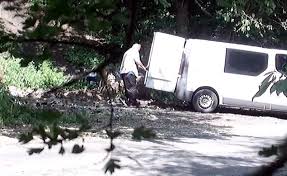
by Pigeon Patrol | Dec 17, 2019 | Bird Deterrent Products, Bird Netting, Bird Spike, Bird Spikes, Pigeon Droppings, Pigeon Patrol's Services, Pigeon Spikes, Pigeons in the News
An Aerial view The City’s downtown core in Regina, SK. on Thursday, August 22, 2013. Salthaven West director of rehabilitation, Megan Lawrence, believes some downtown businesses may be putting out poison to deter pigeons. Several Regina pest control companies contacted by the Leader-Post said they do offer Avitrol, but it can only be administered in commercial and industrial areas and isn’t for retail sale. A trained pest control employee must administer it.
Instead of poison, Lawrence recommends removing structures where pigeons could roost and screen off air conditioning units where they might drink water from. Bristling wires, which prevent pigeons from landing, can also be purchased from a pest control retailer and installed.“If they’re up on the roof and you start seeing them build nest, remove all nesting materials,” she said. “The more times that happens they’re going to realize this isn’t a place (they can) nest.”
Saskatoon woman says people may be using neurotoxin to poison local pigeons
A Saskatoon woman who helps restore injured birds to health is calling on the City of Saskatoon to help curb a trend she says concerns her. Jan Shadick runs Living Sky Wildlife Rehabilitation. She says that since Jan. 1, people have called her about 35 dead pigeons. 
Rate of ‘kidnapped’ baby hares a concern in Saskatoon Based on the symptoms described, Shadick says she “strongly suspects” most of those birds were poisoned.
“The pigeons are convulsing. They’re having seizures,” she said. “One woman contacted me about a dead pigeon in her yard. I think it was in a flower pot and she was concerned because her dog goes out in the yard.” “It’s an animal. It’s a life. And I don’t think it should suffer,” said Shadick. (Guy Quenneville/CBC) Shadick said she believes a particular neurotoxin used to repel birds is to blame. In a public letter to city councillors, she said Saskatoon Light and Power has used that neurotoxin in the past. Brendan Lemke, the acting director of Saskatoon Light and Power, said, “SL&P does not use poison to kill pigeons in or around its substations. “It has, in the past and consistent with best practices, retained the expertise of pest control experts which have used widely accepted chemical repellents for pigeon control, but SL&P has not used those products or services since 2017.” Shadick wants the city to ban use of the product by anyone in the city.
“It’s an animal. It’s a life. And I don’t think it should suffer,” Shadick said Thursday as she grasped a dead pigeon wrapped in a plastic baggie.
Saskatchewan’s Ministry of Environment said it has not granted a permit for the use of the neurotoxin and would only do so “in exceptional circumstances.”
About Pigeon Patrol:
Pigeon Patrol Products & Services is the leading manufacturer and distributor of bird deterrent (control) products in Canada. Pigeon Patrol products have solved pest bird problems in industrial, commercial, and residential settings since 2000, by using safe and humane bird deterrents with only bird and animal friendly solutions. At Pigeon Patrol, we manufacture and offer a variety of bird deterrents, ranging from Ultra-flex Bird Spikes with UV protection, Bird Netting, 4-S Gel and the best Ultrasonic and audible sound devices on the market today.
Contact us at 1- 877– 4– NO-BIRD, (604) 585-9279 or visit our website at www.pigeonpatrol.ca
Bird Gone, Pigeon Gone, Seagull Gone, Pigeon problems, pigeon spikes, 1-877-4NO-BIRD, 4-S Gel, Bird Control, Pigeon Control, bird repellent, Bird Spikes, sonic bird repellent, stainless steel bird spikes, bird spikes Vancouver, Ultra Sonic Bird Control, Bird Netting, Plastic Bird Spikes, Canada bird spike deterrents, Pigeon Pests, B Gone Pigeon, Pigeon Patrol, pest controller, pest control operator, pest control technician, Pigeon Control Products, humane pigeon spikes, pigeon deterrents, pigeon traps, Pigeon repellents, Sound & Laser Deterrents, wildlife control, raccoon, skunk, squirrel deterrent, De-Fence Spikes, Dragons Den, Canada bird spikes, Canada pigeon, pigeon control, pidgon patrol, pidgon. Kill pigeons, crow, starling

by Pigeon Patrol | Oct 22, 2019 | Bird Deterrent Products, Pigeon Control, Pigeon Droppings, Pigeon Patrol's Services, Pigeon Spikes
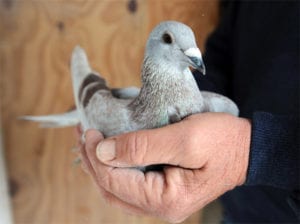
Pigeon in New York City (file / credit: STAN HONDA/AFP/Getty Images)
EOGHAN MacCONNELL
HAND-REARED live pigeons were coated in poison, tethered to the ground and used to kill two wild buzzards near the Tipperary-Offaly border, according to BirdWatch Ireland.
BirdWatch volunteers were horrified to discover the two dead buzzard chicks beside three poisonous tethered pigeons near Roscrea.
BirdWatch Ireland Development Officer Niall Hatch said the banned insecticide Carbofuran used to kill the buzzards is so toxic “a quarter of a teaspoonful is enough to kill a fully grown adult”.
“There is a really serious public safety issue here as well,” he said, “whoever is responsible for planting the poison took a real risk themselves”. Had the pigeons been found by children who attempted to rescue them, “you could be reporting on an even worse story today,” he added.
No motive has yet been established. Buzzards eat rabbits, crows, magpies, rats and mice. They will occasionally feed on a dead lamb, but are incapable of killing a lamb, said Mr Hatch.
An indigenous bird, the buzzard was absent in Ireland from the late 19th century until 1933, when a pair bred in Co Antrim. The species has spread slowly down from the north through the 20th century and is now established in almost every county in Ireland.
BirdWatch Ireland say this was a particularly abhorrent incident.
The live hand-reared pigeons were tethered to the ground as bait, their bodies coated with poison and their wings clipped to prevent any chance of escape.
A day after the dead buzzards were found last month, another live, poison-coated pigeon was discovered tethered in the same area.
The buzzards’ nest in Roscrea was being monitored by two young volunteers from BirdWatch Ireland’s Raptor Conservation Project since early spring. They had been charting the progress of the three young buzzard chicks.
One volunteer said: “we had been watching them all summer and it was sickening to see them killed like that for no reason”.
The farmer on whose land the birds were nesting said: “they have not caused me or any of the other farmers in the area any problems whatsoever. I gave nobody permission to come on my land and lay down poison, and whoever did so was trespassing,” he said.
In October 2010, laws were passed making it illegal to use poison to kill birds or animals, with the exception of rats and mice.
An investigation has been launched and anyone with information is urged to contact the National Parks and Wildlife Service on 057 91 37811 or Birr Garda station on 057 91 69710.
About Pigeon Patrol:
Pigeon Patrol Products & Services is the leading manufacturer and distributor of bird deterrent (control) products in Canada. Pigeon Patrol products have solved pest bird problems in industrial, commercial, and residential settings since 2000, by using safe and humane bird deterrents with only bird and animal friendly solutions. At Pigeon Patrol, we manufacture and offer a variety of bird deterrents, ranging from Ultra-flex Bird Spikes with UV protection, Bird Netting, 4-S Gel and the best Ultrasonic and audible sound devices on the market today.
Contact us at 1- 877– 4– NO-BIRD, (604) 585-9279 or visit our website at www.pigeonpatrol.ca
Bird Gone, Pigeon Gone, Pigeon problems, pigeon spikes, 1-877-4NO-BIRD, 4-S Gel, Bird Control, Pigeon Control, bird repellent, Bird Spikes, sonic bird repellent, stainless steel bird spikes, bird spikes Vancouver, Ultra Sonic Bird Control, Bird Netting, Plastic Bird Spikes, Canada bird spike deterrents, Pigeon Pests, B Gone Pigeon, Pigeon Patrol, pest controller, pest control operator, pest control technician, Pigeon Control Products, humane pigeon spikes, pigeon deterrents, pigeon traps, Pigeon repellents, Sound & Laser Deterrents, wildlife control, raccoon, skunk, squirrel deterrent, De-Fence Spikes, Dragons Den.
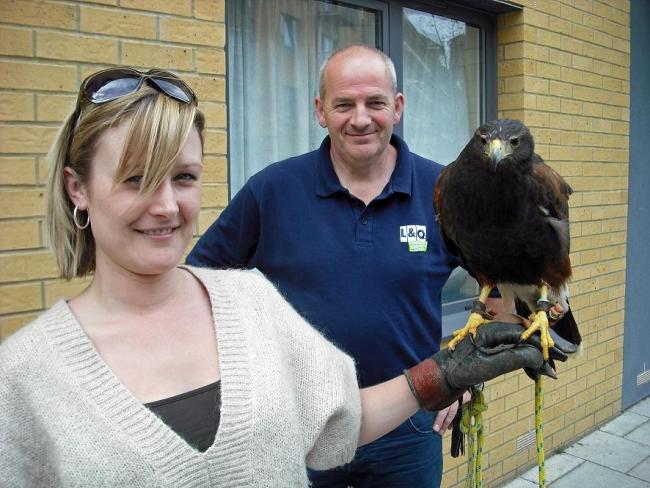
by Pigeon Patrol | Oct 21, 2019 | Animal Deterrent Products, Bird Deterrent Products, Bird Spikes, Pigeon Control, Pigeon Droppings
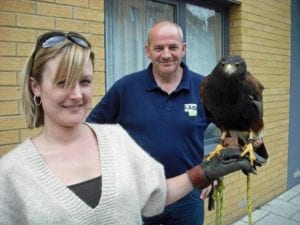
LEYTON: Housing bosses set to use a hawk to keep nuisance pigeons away
By Safira Ali
A HAWK will be used to scare pigeons which are blighting a Leyton estate.
L&Q housing association will be introducing the Harris Hawk to patrol the Beaumont Estate with a handler to get rid of nuisance pigeons.
A spokesman for L&Q housing association said: “We have been talking to residents on the Beaumont Estate and they have told us that the pigeons are causing a real problem. Installing netting or pigeon spikes is not always effective, and it can be very unsightly, so we have been consulting with residents about other options.
“We had similar problems at another L&Q development in Greenwich and found that bringing in a specially trained hawk worked wonders.
“The hawk breaks the habit of the pigeons frequenting an area, and at the end of the programme hawk kites are installed to maintain the deterrent.
“The hawks are very tame and fully insured for public handling, so the children on the estate can interact with the birds and watch what is going on.
“It’s a slightly unusual solution, but the feedback from residents in Greenwich was very positive so we will look at trying it on the Beaumont Estate.”
Local Liberal Democrat councillor Bob Sullivan welcomed the plans. He said he had had numerous complaints from residents about the roosting pigeons messing up their homes.
Cllr Sullivan said: “It is very unusual. Pigeons are a problem all over the place. They roost on the balconies of the flats causing a mess.
“Hopefully the hawk will be able to chase them off. A few people have complained to me about the pigeons. It has been an ongoing problem for years.
“They also roost on the bridge across the road. That is a classic place for pigeons. Putting netting up keeps them away for a while but not for long.
“If they get a hawk it shows that they are looking into the problem. It is something that has to be looked at. It will be interesting to see how it works.”
About Pigeon Patrol:
Pigeon Patrol Products & Services is the leading manufacturer and distributor of bird deterrent (control) products in Canada. Pigeon Patrol products have solved pest bird problems in industrial, commercial, and residential settings since 2000, by using safe and humane bird deterrents with only bird and animal friendly solutions. At Pigeon Patrol, we manufacture and offer a variety of bird deterrents, ranging from Ultra-flex Bird Spikes with UV protection, Bird Netting, 4-S Gel and the best Ultrasonic and audible sound devices on the market today.
Contact us at 1- 877– 4– NO-BIRD, (604) 585-9279 or visit our website at www.pigeonpatrol.ca
Bird Gone, Pigeon Gone, Pigeon problems, pigeon spikes, 1-877-4NO-BIRD, 4-S Gel, Bird Control, Pigeon Control, bird repellent, Bird Spikes, sonic bird repellent, stainless steel bird spikes, bird spikes Vancouver, Ultra Sonic Bird Control, Bird Netting, Plastic Bird Spikes, Canada bird spike deterrents, Pigeon Pests, B Gone Pigeon, Pigeon Patrol, pest controller, pest control operator, pest control technician, Pigeon Control Products, humane pigeon spikes, pigeon deterrents, pigeon traps, Pigeon repellents, Sound & Laser Deterrents, wildlife control, raccoon, skunk, squirrel deterrent, De-Fence Spikes, Dragons Den.
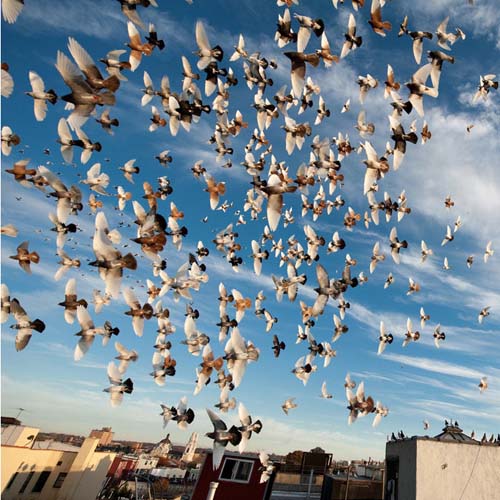
by Pigeon Patrol | Oct 18, 2019 | Animal Deterrent Products, Bird Deterrent Products, Bird Netting, Bird Spikes, Pigeon Control, Pigeon Droppings, Pigeon Patrol's Services, Pigeon Spikes
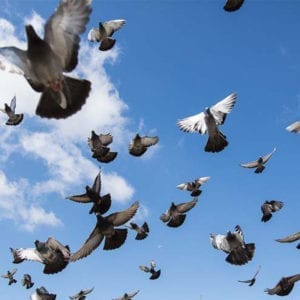
Revealed: the mechanism that allows birds of a feather to flock together
Pigeons loaded with GPS backpacks show the secrets of co-ordinated flight control
Anyone interested in the democratic process could do worse than study the group decisions made by pigeons in mid-flight. Scientists have discovered that pigeon flocks are governed by a kind of “democratic hierarchy” that makes sure everyone flies in the same direction.
With the help of tiny GPS backpacks carried by each member of a loft of pigeons, researchers have discovered how large numbers of animals are able to instantly co-ordinate their movements to ensure that they do things as a group rather than as anarchic individuals.
Although the principle has so far only been demonstrated with a smallish flock of Hungarian pigeons, the scientists believe it could also operate on much bigger groups of animals, such as schools of fish and herds of wild buffalo, and might even explain how close-knit groups of people, such as juries, manage to reach a single decision.
“Anyone who has seen flocks of birds or schools of fish is familiar with this phenomenon of large numbers of individuals in a fast-moving group appearing to move in a co-ordinated way, and it’s not immediately clear how they coordinate themselves,” said Dora Biro, a zoologist at Oxford University.
“Our question was, how do groups like flocks of pigeons make decisions about what to do and where to go?” Dr Biro said.
The GPS backpacks carried by the pigeons enabled the scientists to precisely monitor the birds’ movements, relative to each other, every 0.2 seconds of their journey from the point where the scientists released them to their home loft in Budapest, 15km away.
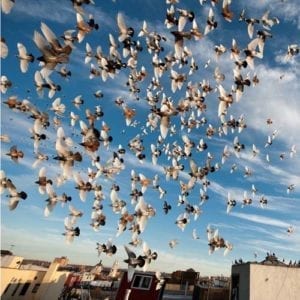
“Previously, people had assumed democratic decisions, where every bird’s preferences are somehow averaged out, and that’s what the group ends up doing. Or there might be a single leader or a small number of leaders that everyone follows,” Dr Biro said.
“But what we were able to do by tracking these birds with individual GPS units was to resolve the leader-follower relationship within the flock. What we found was a more sophisticated and refined mechanism for how the decisions are made,” she said.
“There wasn’t a single leader, nor was there a kind of egalitarian decision-making where everyone had an equal vote. Instead, each bird did have a vote, but the weight that each vote carried differed between birds.
“It represented a kind of hierarchy where the decisions of some birds near the top of the hierarchy carried more weight in terms of what the birds did than the birds lower down the hierarchy, who were still influential but to a lesser degree,” said Dr Biro, who carried out the study with Tamás Vicsek of Eötvös University in Budapest.
“Whether such effects come from some individuals being more motivated to lead, or being inherently better navigators perhaps with greater navigational knowledge, is an intriguing question we don’t yet have an answer to,” Dr Biro said.
The loft of pigeons in the study consisted of 10 birds whose every movement was recorded as they flew in a flock from one location to another. The analysis, published in the journal Nature, described how each bird moved in relation to its neighbours, with some individuals leading more than others.
“It’s neither a completely democratic system, where everybody gets the vote, nor [one with] a single leader or a few leaders responsible for the decisions. But in fact every individual gets a kind of input into what the group as a whole should do,” Dr Biro said.
“If this was honed by evolution, if there was a selective advantage for individuals in the group to make decisions in this way, then it might represent a particularly efficient form of group decision making… It is possible that the mechanism we saw in these pigeons generalises to other species and to other group decision-making contexts, even in humans,” Dr Biro said.
About Pigeon Patrol:
Pigeon Patrol Products & Services is the leading manufacturer and distributor of bird deterrent (control) products in Canada. Pigeon Patrol products have solved pest bird problems in industrial, commercial, and residential settings since 2000, by using safe and humane bird deterrents with only bird and animal friendly solutions. At Pigeon Patrol, we manufacture and offer a variety of bird deterrents, ranging from Ultra-flex Bird Spikes with UV protection, Bird Netting, 4-S Gel and the best Ultrasonic and audible sound devices on the market today.
Contact us at 1- 877– 4– NO-BIRD, (604) 585-9279 or visit our website at www.pigeonpatrol.ca
Bird Gone, Pigeon Gone, Pigeon problems, pigeon spikes, 1-877-4NO-BIRD, 4-S Gel, Bird Control, Pigeon Control, bird repellent, Bird Spikes, sonic bird repellent, stainless steel bird spikes, bird spikes Vancouver, Ultra Sonic Bird Control, Bird Netting, Plastic Bird Spikes, Canada bird spike deterrents, Pigeon Pests, B Gone Pigeon, Pigeon Patrol, pest controller, pest control operator, pest control technician, Pigeon Control Products, humane pigeon spikes, pigeon deterrents, pigeon traps, Pigeon repellents, Sound & Laser Deterrents, wildlife control, raccoon, skunk, squirrel deterrent, De-Fence Spikes, Dragons Den.










